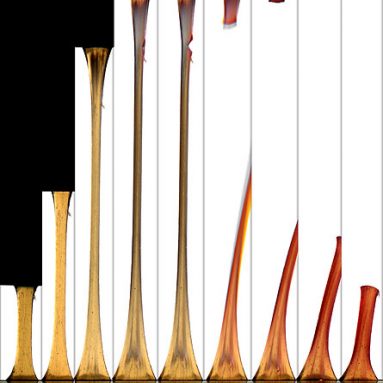Seeing red means danger ahead
A tiny molecule may make a big difference in future warning systems
 |
|
A polymer containing a color-changing molecule called a mechanophore turns red seconds before it snaps. The technology may one day allow damage to materials or structures to be easily spotted.
|
| D. Stevenson, A. Jerez, A. Hamilton and D. Davis |
The color red often means danger — and by paying attention, accidents can be prevented. At railroad crossings, flashing red lights warn cars to stay back. A red light at a traffic intersection tells cars to stop, so they don’t run into other cars. And when a driver steps on the brakes, bright red taillights warn cars behind to slow down.
In the future, the color red also may help prevent danger at construction sites. Thanks to new work by engineers, bridge supports — or other kinds of materials — could one day contain a new kind of material that turns red before a structure collapses or falls apart.
The secret behind the color-changing material is a particular type of molecule. A molecule is a group of atoms held together by chemical bonds. Molecules come in all shapes and sizes, and make up everything you can see, touch or feel.
How a molecule behaves depends on what kinds of atoms it contains, and how they’re held together.
To get a rough picture of one way atoms are held together in a molecule, imagine you and your friends standing in a large circle, holding hands. Each person represents one atom, your clasped hands represent the bonds, and the entire circle represents a molecule.
The molecule being used to turn the material it’s in red is called a mechanophore. When one bond in the mechanophore molecule breaks, the rest of the molecule turns red. (Imagine your circle of friends again, and try to imagine that if two people let go, everyone turns bright red.)
 |
|
When humans are injured, we bruise and our skin changes color. When a polymer containing a color-changing molecule called a mechanophore is about to break, it also produces a color. The process is similar. An injury breaks blood vessels under the surface
|
| Kemter/iStockphoto |
“It’s a really simple detection method,” says Nancy Sottos, one of the scientists who worked on the project. “We’re opening up this one bond, and it changes color.” Sottos works on the science of different kinds of materials at the Beckman Institute for Advanced Science and Technology at the University of Illinois at Urbana-Champaign.
Sottos and her team tested the color-changing molecule in two different kinds of polymers, long chains of similar atoms or molecules linked together. First, the team put the mechanophore into a stretchy, soft polymer — not so unlike a rubber band. When the researchers stretched the material, it turned bright red a few seconds before it snapped into two pieces. When they repeatedly stretched and relaxed the polymer, without breaking it, it started to turn red.
They also tested the molecule in beads of a brittle, glasslike polymer. When the beads were squeezed (but not hard enough to shatter), they turned red.
There is a way to get rid of the red color: light. When the scientists shone a bright light on the mechanophore, the broken bond was fixed — and the red danger sign disappeared. This “self-healing” may be a problem for engineers who want to use the color-changer in big construction projects that will be outside, in sunlight. And if bright light keeps the red hue from appearing, then the mechanophore’s warning system will be useless.
Sottos and her fellow scientists still have a lot of work to do before the color-changing molecules can be used outside the lab. If mechanophores can be used in the real world, she suggests employing them in a new kind of paint or even rollerblade wheels.
Going Deeper:







